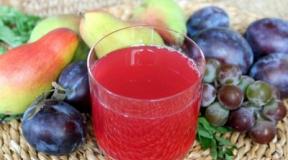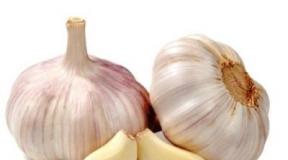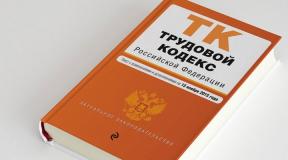Stevia herb is a natural sugar substitute, beauty and health benefits. The benefits and harms of stevia What is stevia, what is useful
02.02.2018
Here you will learn all the details about the sweetener called stevia: what it is, what are the health benefits and possible harm from its use, how it is used in cooking, and much more. It has been used as a sweetener and as a medicinal herb in cultures around the world for centuries, but in recent decades it has gained particular popularity as a sugar substitute for diabetics and for weight loss. Stevia has been further studied, studies have been conducted in order to identify its medicinal properties and contraindications for use.
Stevia is an herb of South American origin whose leaves are used to produce a natural sweetener in powdered or liquid form due to their strong sweetness.
Stevia leaves are about 10-15 times and leaf extract 200-350 times sweeter than regular sugar. Stevia has almost zero calories and contains no carbohydrates. This has made it a popular option for sweetening a variety of foods and drinks for those looking to lose weight or are on a low-carb diet.
What does stevia look like - photo
general description
Stevia is a small perennial herb that belongs to the Asteraceae family and the genus Stevia. Its scientific name is Stevia rebaudiana.
Some other names for stevia are honey grass, sweet biennial.
There are 150 species of this plant, all of which are native to North and South America.
Stevia grows 60-120 cm in height, it has thin, branched stems. It grows well in temperate climates and in parts of tropical regions. Stevia is grown commercially in Japan, China, Thailand, Paraguay, and Brazil. Today, China is the leading exporter of these products.

Almost all parts of the plant are sweet, but most of the sweetness is concentrated in the dark green serrated leaves.
How to get it
Stevia plants usually start their lives in a greenhouse. When they reach 8-10 cm, they are planted in the field.
When little white flowers appear, the stevia is ready to be harvested.

After harvesting, the leaves are dried. The sweetness is released from the leaves through a process that involves soaking them in water, filtering and purifying, and drying them, resulting in a crystallized stevia leaf extract.
Sweet compounds - stevioside and rebaudioside - are isolated and extracted from stevia leaves and further processed into powder, capsule or liquid form.
What smell and taste
Raw, unprocessed stevia often has a bitter taste and an unpleasant odor. After processing, bleaching or discoloration, it acquires a soft, licorice flavor.
Many who have tried stevia sweetener can't help but agree that it has a bitter aftertaste. Some even believe that bitterness is enhanced when stevia is added to hot drinks. It's a little hard to get used to, but it's possible.
Depending on the manufacturer and form of stevia, this aftertaste may be less pronounced or absent altogether.
How to choose and where to buy
Stevia-based sugar substitutes are sold in several forms:
- powder;
- granules;
- pills;
- liquid.
The price of stevia varies greatly depending on the type and brand.
When buying stevia, read the ingredients on the package to make sure it's 100% pure. Many manufacturers supplement it with artificial sweeteners based on chemicals, which can significantly reduce the benefits of stevia. Brands that contain dextrose (glucose) or maltodextrin (starch) should be treated with caution.
Some of the products labeled "Stevia" are not actually pure extract and may contain only a small percentage. Always read labels if you care about health benefits and want to buy quality products.
Stevia extract in powder and liquid form is 200 times sweeter than sugar than its whole or dried ground leaves, which are anywhere from 10 to 40 times sweeter.
Liquid stevia may contain alcohol, and are often available in vanilla or hazelnut flavors.
Some powdered stevia products contain inulin, a natural plant fiber.
A good version of stevia can be purchased at a pharmacy, health supply store, or this online store.
How and how much is stored
The shelf life of stevia-based sweeteners usually depends on the form of the product: powder, tablets, or liquid.
Each brand of stevia sweetener has its own recommended shelf life for their products, which can be up to three years from the date of manufacture. Check the label for more details.
Chemical composition
The herb stevia is very low in calories, contains less than five grams of carbohydrates, and is thought to have almost 0 kcal. At the same time, its dry leaves are about 40 times sweeter than sugar. This sweetness is due to the content of several glycosidic compounds:
- stevioside;
- steviolbioside;
- rebaudiosides A and E;
- dulcoside.
Two compounds are mainly responsible for the sweet taste:
- Rebaudioside A is the most commonly extracted and used in stevia powders and sweeteners, but it's usually not the only ingredient. Most stevia sweeteners on the market contain additives such as erythritol from corn, dextrose, or other artificial sweeteners.
- Stevioside makes up about 10% of the sweetness in stevia, but gives it an unusual bitter aftertaste that many people don't like. It also has most of the health benefits of stevia that have been attributed to it and are the most well-researched.
Stevioside is a non-carbohydrate glycosidic compound. Therefore, it does not have the properties of sucrose and other carbohydrates. Stevia extract, like rebaudioside A, was found to be 300 times sweeter than sugar. In addition, it has several unique properties such as long shelf life, high temperature resistance.

The stevia plant contains many sterols and antioxidant compounds such as triterpenes, flavonoids, and tannins.
Here are some of the flavonoid polyphenolic antioxidant phytochemicals present in stevia:
- kaempferol;
- quercetin;
- chlorogenic acid;
- caffeic acid;
- isoquercetin;
- isosteviol.
Stevia contains many vital minerals, vitamins that are usually missing from artificial sweeteners.
Studies have shown that the kaempferol found in stevia can reduce the risk of pancreatic cancer by 23% (American Journal of Epidemiology).
Chlorogenic acid reduces the enzymatic conversion of glycogen to glucose in addition to reducing intestinal absorption of glucose. Thus, it helps to lower blood sugar levels. Laboratory studies also confirm a decrease in blood glucose levels and an increase in the concentration of glucose-6-phosphate in the liver and glycogen.
Certain glycosides in stevia extract have been found to dilate blood vessels, increase sodium excretion, and increase urine output. In fact, stevia, at slightly higher doses than as a sweetener, can lower blood pressure.
As a non-carbohydrate sweetener, stevia did not promote the growth of Streptococcus mutans bacteria in the mouth, which is attributed to causing cavities.
Stevia as a sweetener - the benefits and harms
What makes stevia so popular with people with type 2 diabetes is that it sweetens food without raising blood glucose levels. This sugar substitute has practically no calories and carbohydrates, so not only diabetics, but also healthy people are not averse to introducing it into their daily diet.
Can stevia be used for diabetes and healthy people
Stevia can be used by diabetics as an alternative to sugar. It is better than any other substitute as it is derived from a natural plant extract and does not contain any carcinogenic or any other harmful substances. However, endocrinologists recommend that their patients try to cut back on sweeteners or avoid them altogether.
For healthy people, stevia is not required, as the body itself is able to limit sugar and produce insulin. In such a case, the best option would be to limit your sugar intake rather than use other sweeteners.
Stevia diet pills - negative review
In the 1980s, animal studies were conducted that concluded that stevia may be carcinogenic and cause fertility problems, but the evidence remained inconclusive. In 2008, the US Food and Drug Administration (FDA) determined a purified stevia extract (specifically rebaudioside A) to be safe.
However, whole leaves or crude stevia extract have not been approved for use in foods and beverages due to a lack of research. However, numerous testimonials from people claim that whole leaf stevia is a safe alternative to sugar or its artificial counterparts. The experience of using this herb for centuries in Japan and South America as a natural sweetener and health product confirms this.
And although leaf stevia is not approved for commercial distribution, it is still grown for home use and is actively used in cooking.
Comparison of which is better: stevia, xylitol or fructose
| stevia | Xylitol | Fructose |
|---|---|---|
| Stevia is the only natural, calorie-free, zero-glycemic alternative to sugar. | Xylitol is found in mushrooms, fruits and vegetables. For commercial production, it is extracted from birch and corn. | Fructose is a natural sweetener found in honey, fruits, berries and vegetables. |
| Does not increase blood sugar levels and does not cause an increase in triglycerides or cholesterol levels. | The glycemic index is low, slightly raising blood sugar levels when consumed. | She has a low glycemic index, but at the same time there is a rapid transformation into lipids, the level of cholesterol and triglycerides increases. |
| Unlike artificial sweeteners, it does not contain harmful chemicals. | May increase blood pressure. | |
| Stevia can help with weight loss because it contains no calories. | When consumed in excess of foods containing fructose, obesity, heart and liver problems occur. |
Health Benefits
As a result of the study of stevia, its medicinal properties were revealed:
For diabetes
Studies have shown that the stevia sweetener does not add calories or carbohydrates to the diet. Its glycemic index is zero (meaning that stevia does not affect blood sugar levels). This allows diabetics to eat more varied foods and still eat a healthy diet.
For weight loss
There are many causes of overweight and obesity: physical inactivity and increased consumption of energy-dense foods high in fat and sugars. Stevia contains no sugar and is very low in calories. It can be part of a balanced weight loss diet to reduce energy intake without sacrificing taste.
With oncological diseases
Stevia contains many sterols and antioxidant compounds, including kaempferol, which has been shown to reduce the risk of pancreatic cancer by 23%.
With hypertension
The glycosides contained in stevia are able to dilate blood vessels. They also increase sodium excretion and act as a diuretic. A 2003 study showed that stevia could potentially help lower blood pressure. But further research is needed to confirm this beneficial property.
So, the health benefits of stevia require further study before they can be confirmed. However, rest assured that stevia is safe for diabetics when consumed as an alternative to sugar.
Contraindications (harm) and side effects
The benefits and possible harms of stevia depend on what form you prefer to consume and on its quantity. There is a huge difference between pure extract and chemically processed foods with a small percentage of stevia added.
But even if you choose high-quality stevia, it is not recommended to consume more than 3-4 milligrams per kilogram of body weight per day.
Here are the main side effects that can cause harm to health due to excess dosage:
- If you have low blood pressure, stevia can cause it to drop even more.
- Some liquid forms of stevia contain alcohol, and people with alcohol sensitivities may experience bloating, nausea, and diarrhea.
- Anyone allergic to ragweed, marigolds, chrysanthemums, and daisies may have a similar allergic reaction to stevia, since this herb is from the same family.
In one animal study, excessive consumption of stevia was found to reduce the fertility of male rats. But since this only happens when it is consumed in high doses, this effect may not be seen in humans.
During pregnancy
Adding a drop of stevia to a cup of tea from time to time is unlikely to cause harm, but it is best not to use it during pregnancy or while breastfeeding due to the lack of research in this area. In cases where pregnant women need sugar substitutes, it is recommended to use them without exceeding the dosage.
Application in cooking
Worldwide, over 5,000 food and drink products currently contain stevia as an ingredient:
- ice cream;
- Dessert;
- sauces;
- yogurts;
- pickled foods;
- bread;
- soft drinks;
- chewing gum;
- candies;
- seafood.
Stevia is well suited for cooking and baking, unlike some artificial and chemical sweeteners that break down at high temperatures. It not only sweetens, but also enhances the taste of products.

Stevia is heat tolerant up to 200 C, making it an ideal sugar substitute for many recipes:
- In powder form, it is ideal for baking, as it is similar in texture to sugar.
- Liquid Stevia Concentrate is ideal for liquid dishes such as soups, stews and sauces.
How to use as a sugar substitute
Stevia can be used in place of regular sugar in foods and drinks.
- 1 teaspoon sugar = 1/8 teaspoon powdered stevia = 5 drops liquid
- 1 tablespoon sugar = 1/3 teaspoon powdered stevia = 15 drops liquid stevia
- 1 cup sugar = 2 tablespoons stevia powder = 2 teaspoons liquid stevia.

The sugar-to-stevia ratio can vary from manufacturer to manufacturer, so read the packaging before adding any sweetener. Using too much of this sweetener can result in a noticeable bitter taste.
General instructions for use
In almost any recipe, you can use stevia, for example, cook jam or jam, bake cookies. To do this, use the universal tips on how to replace sugar with stevia:
- Step 1 . Combine the ingredients as directed in the recipe until you get to the sugar. Replace sugar with stevia according to the form you have. Since stevia is much sweeter than sugar, an equivalent replacement is not possible. See previous section for measurement.
- Step 2. Since the amount of stevia to replace is much less than sugar, more other ingredients will need to be added to make up for the weight loss and balance the dish. For each cup of sugar you've replaced, add 1/3 cup of a liquid such as applesauce, yogurt, fruit juice, egg whites, or water (whatever is in the recipe).
- Step 3 Mix all other ingredients and follow the rest of the recipe.
An important nuance: if you intend to make jam or puree with stevia, then they will have a rather short shelf life (maximum one week in the refrigerator). For long term storage, freeze them.
To get a thick consistency of the product, you will also need a gelling agent - pectin.
Sugar is one of the most dangerous ingredients in food. This is why alternative natural sweeteners such as stevia are becoming more and more popular as they are not harmful to health.
Stevia is a perennial herb that has a rich, sweet leaf flavor. This property allows the plant to be used in place of sugar by adding the leaves to dishes and drinks.
Industrially produced from a plant, which is very popular with diabetics.
What is stevia used for?
 The main use of honey grass is to add to food and drinks as a sweetener.
The main use of honey grass is to add to food and drinks as a sweetener.
This is most justified for those who want to lose weight, and if necessary, control the amount of carbohydrates entering the body.
The use helps to remove excess fluid from the body, which reduces swelling and reduces weight.
The plant is often used for medicinal purposes. Its use is useful in case of refusal of nicotine addiction, when they try to replace the craving for a cigarette with eating candy.
The plant is used for the prevention and treatment of diseases of the cardiovascular, digestive and urinary systems.
Healing infusion showed itself well:
- Pour 20 g of crushed grass leaves into 250 ml of water and then simmer for 5 minutes from the moment of boiling over low heat. Leave to settle for a day. If you use a thermos, then the settling time is about 9 hours.
- Filter and pour 100 ml of boiled water into the remaining mass. After 6 hours of settling in a thermos, filter and combine both infusions. Add infusion to drinks and cooked dishes. The tincture is stored for no longer than a week.
To reduce appetite, it is enough to drink a tablespoon of infusion before eating.
For weight loss, you can make tea and drink it before breakfast and dinner. Boil 200 ml of water, add 20 g of raw materials and leave for 5 minutes.
An infusion of the leaves is used as a hair rinse. It strengthens the hair follicles, reduces hair loss and eliminates dandruff.
You can wipe the skin of the face with it in its pure form or after freezing, to dry oily skin and remove acne.
Chopped herb steamed with boiling water narrows enlarged pores well, eliminates irritation and wrinkles, and improves skin tone when used as a mask. The procedure should be carried out once a week for two months.
Benefit and harm
 The popularity of this sweetener among diabetics and overweight people is due to the low calorie content of the plant. Only 18 kcal is contained in 100 g of fresh leaves, and the calorie content in the extract is zero.
The popularity of this sweetener among diabetics and overweight people is due to the low calorie content of the plant. Only 18 kcal is contained in 100 g of fresh leaves, and the calorie content in the extract is zero.
In addition, there are no proteins and fats in stevia, and it contains 0.1 g of carbohydrates per 100 g of product. Thus, replacing sugar with honey grass, in combination with dietary nutrition, will help to gradually get rid of extra pounds.
The plant does not harm health and has practically no contraindications, except for individual susceptibility to the components of the plant composition.
But the beneficial properties of honey grass are widely known and are successfully used both in folk and traditional medicine:
- cleanses blood vessels from atherosclerotic plaques, strengthens the vascular walls and heart muscle;
- improves blood circulation and lowers blood pressure;
- stimulates brain activity and increases physical endurance, providing the body with energy;
- inhibits the development of bacteria and improves tissue regeneration;
- normalizes the acidity of the stomach;
- stimulates the synthesis of insulin, which helps to reduce the level of sugar in the blood plasma;
- restores metabolic processes;
- promotes the removal of toxic substances and toxins;
- improves the functionality of the pancreas and liver;
- suppresses pathogens of viral infections, has an antiseptic effect;
- liquefies sputum and promotes its removal;
- increases the body's defenses and resistance to viral and colds;
- calms the nervous system;
- prevents and treats diseases of the oral cavity, strengthens tooth enamel and prevents the formation of tartar;
- slows down the aging of the body;
- has an antimicrobial, antifungal and anti-allergic effect;
- relieves irritation, promotes rapid healing of skin lesions.
It is believed that the plant slows down the growth of oncological tumors, promotes skin rejuvenation and protects teeth from decay. In addition, honey grass can have a beneficial effect on male sexual function, eliminating problems with potency.
The use of preparations from the plant helps to overcome cravings for sweets, reduce appetite and normalize metabolic processes, which can be used to effectively combat extra pounds.
Video from Dr. Malysheva about sweetener:
Instructions for use
How to use stevia? Honey grass can be used in its natural form. Its leaves are added to dishes and drinks fresh or pre-dried.
In addition, the plant can be used in the following forms:
- water decoction of the leaves;
- herbal tea from crushed leaves of the plant;
- plant extract in the form of syrup;
- concentrated drug in the form of tablets;
- dry extract in the form of a white powder.
Given that fresh leaves are 30 times sweeter than ordinary sugar, and a concentrated extract is more than three hundred times sweeter, the use of plant preparations of different forms requires differences in dosage.
Table of comparative dosages:
| Sugar | Leaves | Syrup | Powder |
|---|---|---|---|
| 1 tsp | Quarter teaspoon | 2-5 drops | On the tip of a knife |
| 1 st. l. | Three quarters of a teaspoon | 0.8 teaspoon | On the tip of a spoon |
| 1 glass | Tablespoon | 1 teaspoon | Half teaspoon |
To use honey herb preparations in the process of baking or other dishes, it will be more convenient to use the plant in the form of a powder or syrup.
For adding to drinks, it is better to use the extract in the form of tablets.
For canning, fresh or dried leaves of the plant are more suitable.
The grass does not change its properties under the influence of high temperatures, therefore it is excellent as a sweetener for cooking hot dishes and baking.
Indications for admission
The medicinal properties of the plant allow it to be used to treat the following pathologies:
- Diseases caused by metabolic disorders. The ability of honey grass to have a beneficial effect on carbohydrate and fat metabolism, and naturally lower the concentration of sugar in the blood plasma, allows it to be successfully used in complex therapy for diabetes.
- Pathologies of the digestive system. Stevia helps alleviate gastritis, improve liver function, restore intestinal microflora in dysbacteriosis.
- Diseases of the cardiovascular system. Regular use of stevioside helps to cleanse the vascular walls of cholesterol plaques and eliminate vascular spasms. It can be used to treat hypertension and atherosclerosis, strengthen the heart muscle and prevent the development of cardiac ischemia.
- The plant actively fights viruses and inhibits the development of bacteria, stimulates the excretion of sputum. Therefore, it is advisable to use it for the treatment of diseases of the bronchopulmonary system caused by viruses and the common cold.
- The plant is also used as an anti-inflammatory and wound healing agent for joint pathologies, stomach ulcers, and skin lesions. Stevia decoction is used to treat acne, boils, burns and wounds.
- It is believed that the plant inhibits the growth of neoplasms and prevents the appearance of new tumors.
They use stevia to strengthen the body's defenses and saturate it with vitamins, use the herb to rejuvenate and improve skin tone, to strengthen hair follicles and to treat diseases of the oral cavity.
Video review of the characteristics of sugar and stevia:
Contraindications and side effects
The plant has practically no contraindications, but some categories of people should use it with caution and after consulting a doctor:
- lactating women;
- pregnant women;
- Small children;
- people with chronic hypotension;
- persons suffering from diseases of the digestive and urinary systems;
- people with nervous disorders;
- persons in the period of rehabilitation after surgery;
- patients with endocrine and hormonal disorders.
Do not use stevia preparations in combination with dairy products in order to prevent the occurrence of indigestion.
With caution, the plant should be used by people who take vitamin complexes and consume a large amount of vegetable vitamin food, otherwise there is a high probability of developing pathologies associated with an excess of vitamins.
Chemical composition
The following useful substances can be attributed to the components of the composition of stevia:
- arachidonic, chlorogenic, formic, gebberellic, caffeic and linolenic acid;
- flavonoids and carotene;
- ascorbic acid and B vitamins;
- vitamins A and PP;
- essential oils;
- dulcoside and rebaudioside;
- stevioside and inulin;
- tannins and pectins;
- minerals (selenium, calcium, copper, phosphorus, chromium, zinc, potassium, silicon, magnesium).
What can be replaced?
 What to do if you are allergic to stevia? You can replace it with another sweetener, such as fructose.
What to do if you are allergic to stevia? You can replace it with another sweetener, such as fructose.
Just keep in mind that fructose is rich in carbohydrates and can affect the increase in blood sugar. Therefore, fructose should be used with caution, especially in patients with diabetes.
There are many options for sweeteners, both natural and synthetic. Which one to choose, everyone decides for himself.
If the need to use a sweetener is caused by a disease of the endocrine system, then it is necessary to consult a doctor before choosing sugar substitutes.
In terms of its sweetness, the plant surpasses sugar by 15-20 times, shocking everyone with its low calorie content - 100 g of the product contains only 18 kcal. Such characteristics are not inherent in all types of plants. To replace sugar and for preventive purposes, honey stevia is used. The remaining subspecies growing in natural conditions are not so valuable, because they contain natural sweet substances in too small quantities.
Plant features
Stevia is a lover of heat and dry climate, therefore it grows in subtropical latitudes. The homeland of the plant is considered to be South and Central America (Brazil, Paraguay). It grows in semi-arid conditions, both in the highlands and on the plains. Stevia seeds have very poor germination, so it is propagated vegetatively.
Due to its excellent taste, as well as high antioxidant abilities, stevia is actively cultivated by eastern countries - Japan, China, Indonesia, and Thailand. Breeding and selection of new sweet species are carried out in Ukraine, Israel, and the USA.
It is also popular to grow stevia at home as a houseplant. After wintering, the grass is planted in open ground. Over the summer, a small bush grows beautifully, allowing you to collect an impressive crop of sweet leaves.
Botanical description
Stevia is a herbaceous perennial bush, formed as a result of active branching of the main stems. Its height can reach 120 cm. Under adverse climatic conditions, stevia does not branch and grows like a grass with a thick stem about 60 cm long.
- root system. Long and even cord-like roots form a fibrous stevia rooting system, penetrating deep into the soil up to 40 cm.
- stems. Lateral branches extend from the main stem. The shape is cylindrical. Active branching forms a voluminous bush of a trapezoid shape.
- Leaves . 2-3 cm long, have an obovate shape and a slightly crenate edge. Dense in structure, the leaves do not have stipules, sit on a shortened petiole. The placement is cross-opposite.
- Flowers. Stevia flowers are white, small, collected 5-7 pieces in small baskets.
- Fruits. During the fruiting period, small boxes appear on the bushes, spindle-shaped seeds 1-2 mm long spill out of them.
When growing a plant in room conditions, to form a bush, it is necessary to regularly cut off the tops of the stems.
Procurement of raw materials
Stevia leaves are used as a medicinal raw material and natural sweetener. They are harvested before flowering, when buds appear on the shoots of the plant. It is at this time that the concentration of sweet substances in the leaves becomes maximum.
To harvest the leaves, the stems of the plant are cut off, retreating 10 cm from the ground. After cutting, the lower leaves are torn off, and the stems are laid out on a cotton fabric in a thin layer or hung tied up in small panicles.
Stevia should be dried in the shade, with good ventilation. In hot weather, the stems dry out completely in 10 hours, which ensures the high quality of plant materials. To maintain the maximum concentration of steviol glycosides, it is recommended to harvest the plant using dryers.
The quality of dried leaves and their sweetness depend on the drying time. At high humidity and low temperature conditions, this leads to the loss of 1/3 of the total amount of steviols in 3 days.
After complete drying, the leaves are removed from the stems, packed in paper or plastic bags. Low humidity and good ventilation allow raw materials to be stored for 2 years.
At the time of discovery, stevia became not only the leader in the content of sweet substances, but also the plant with the greatest antioxidant effect. The complex chemical composition will help preserve youth, neutralize the influence of negative exogenous factors, and restore the functioning of damaged cells. The plant contains a variety of biologically active substances.
The chemical composition of the plant allows it to be used for therapeutic and prophylactic purposes, as a remedy with versatile pharmacological properties:
- it is a source of vitamins and microelements;
- blood pressure stabilizer;
- immunomodulatory agent;
- plant with antitoxic properties;
- hypoglycemic agent;
- plant with antimicrobial effect.
The high concentration of glycosides allows the plant to be used as a sweetener and industrially processed to produce sweeteners. Small doses of stevia give foods a sweet taste, rich infusions and decoctions have a bitter aftertaste due to the increased concentration of steviol glycosides.
The benefits of stevia for different body systems
The beneficial properties of stevia are actively used by traditional and folk medicine, for the treatment and prevention of many diseases.
Cardiovascular
Stevia is able to regulate blood pressure. Small doses help to reduce it. High doses, on the contrary, stimulate an increase in pressure. The mild, gradual action of the plant is completely safe for hypo- and hypertensive patients. Also, the property of stevia has been proven to normalize the heart rate and the strength of heart contractions. A positive effect on the vessels allows you to eliminate congestion, spasm, and normalize the tone of the venous walls. The herb reduces the concentration of bad cholesterol in the blood, helps to eliminate the plaques formed on the walls of the arteries. The plant can be regularly consumed internally for the treatment and prevention of:
- vegetovascular dystonia;
- ischemic heart disease;
- hypertension;
- myocardial infarction;
- atherosclerosis;
- varicose veins.
With fluctuations in blood pressure and its sharp jumps, dose selection should be very careful. The focus is on the well-being of the patient.
Endocrine
The most common use of stevia leaves is to normalize blood glucose levels in diabetes mellitus. The effect is due to inhibition of glucose absorption. Against the background of the use of stevia, diabetics note an improvement in well-being, as well as a decrease in the need for insulin from outside. With the constant use of the plant, the dosage of the hormone is gradually reduced.
The herb is able to restore the work of pancreatic cells. In some cases of type 2 diabetes, there is a complete recovery after the use of stevia.
The plant improves the production of thyroid hormones, normalizes the level of sex hormones. Macro- and microelements necessary for hormonal synthesis, normal functioning of the endocrine system are contained in the leaves of the plant.
immune
Vitamins and macronutrients that are part of stevia activate the body's defenses. This is useful when immunity is reduced due to previous diseases, during the cold season. The ability of stevia to eliminate the reactive response of the immune system to allergens entering the body is known. This effect is necessary for allergic reactions such as urticaria and dermatitis, as well as for the treatment and prevention of the following autoimmune skin diseases:
- psoriasis;
- eczema;
- idiopathic dermatitis;
- seborrhea.
The antitumor effect of stevia is based on the ability of the plant to neutralize and eliminate free radicals. The same mechanism underlies the slowing down of the aging process by grass. The antimicrobial and antifungal properties of stevia help in the treatment of wounds, including weeping, purulent, trophic ulcers, and fungal skin lesions.
digestive
Stevia has a beneficial effect on all digestive organs. The plant normalizes the secretion of digestive juices and acidity in the stomach, improving the absorption of food. Enveloping properties are useful for gastritis and peptic ulcer disease.
The use of stevia is recommended for weight loss. In the fight against obesity, not only the ability of the plant to replace sugar, reducing the calorie content of food consumed, but also to prevent the occurrence of insulin surges, the cause of sudden and severe bouts of hunger, is appropriate.
nervous
Stevia restores the functioning of nerve fibers, normalizes the conduction of impulses through them. The plant helps fight migraine attacks. Stevia is also known to have a sedative effect. The use of drugs helps to cope with the following conditions:
- eliminates anxiety attacks;
- fights insomnia;
- promotes concentration;
- neutralizes nervous tension;
- helps fight chronic fatigue;
- treats depression and blues;
- activates the internal potential of the body;
- has adaptogenic properties;
- increases endurance.
Daily moderate use of stevia is recommended for athletes, as well as with an increase in psychological and physical stress, as an anti-stress and light tonic.
Non-medical use of raw materials
Stevia is recommended as a safe sweetener for diabetics. Tablets are used, the active substance of which is stevioside - an extract from a plant. Arnebia's natural stevia sugar substitute is packaged in convenient automatic dispensers, similar to Milford's, but contains a better and safer alternative to its analogue aspartame.
The stevia sweetener is actively used to create a line of diet food from the Leovit trademark. This sweetener is used in cereals and desserts. For diabetics, there are even stevia-based chocolates and vanilla extract for homemade confectionery.
Stevia infusions are also used for cosmetic purposes - to eliminate age spots, lighten the skin and rejuvenate it. Known ability of the plant to normalize the condition of the scalp, eliminate dandruff, including seborrheic origin. The use of dietary supplements with stevia has a positive effect on the appearance of the skin.
homemade recipes
Dry extract of stevia is manufactured industrially, contains sweet substances from the plant, is called "Stevioside". At the same time, the manufacturer does not aim to preserve the entire chemical composition of the herb in the extract. It is for this reason that for a comprehensive recovery of the body, for the purpose of losing weight, preventing and treating diseases, the use of stevia in the form of dried or fresh leaves is recommended.
Dosage forms prepared according to special recipes can be used externally, used in cooking to improve the taste of dishes, tea, coffee. Stevia syrup is prepared separately, which is used instead of sugar. A recipe for herbal tea is popular, which is drunk as an independent drink or added to another drink.
Infusion
- 20 g of crushed leaves fall asleep in a thermos.
- Pour in a glass of boiling water.
- Leave to infuse throughout the day.
- Filter, pour the cake with half a glass of boiling water.
- Strain to the first infusion after eight hours.
Syrup
- Prepare an infusion of the plant according to the previous recipe.
- Place it in a heavy bottomed saucepan.
- Evaporate over low heat until thick, characteristic of syrup.
- Readiness is checked by dropping the product on a saucer - the drop should not spread.
Decoction
- Two tablespoons of leaves pour a glass of boiling water.
- Bring to a boil, cook over low heat for 30 minutes.
- The water is drained, the leaves are poured with half a glass of boiling water.
- The mixture is insisted for 30 minutes, after which it is filtered to the first broth.
Extract
- 20 g of leaves are poured with a glass of alcohol or vodka.
- Heat over low heat or in a water bath for 30 minutes, avoiding boiling.
- After a short cooling, the mixture is filtered.

herbal tea
- One tablespoon without a slide of whole or chopped stevia leaves is poured with a glass of boiling water.
- After 20 minutes of infusion, tea can be consumed.
If stevia is taken for prevention, it is enough to replace it with sugar consumed daily. For the treatment of diseases, obtaining a tonic effect, it is recommended to drink herbal tea from the leaves.
In pharmacies, you can buy a ready-made extract from the plant - a white free-flowing powder in jars or sachets. They cook pastries, compotes, cereals with it. For brewing tea, it is better to purchase stevia leaf powder or filter bags with crushed raw materials.
Of the dietary supplements, the Stevia Plus sugar substitute in tablets is popular. In addition to stevioside, this preparation contains chicory, as well as licorice extract and vitamin C. This composition allows the use of a sweetener as an additional source of inulin, flavonoids, and amino acids.
It is also known about the practice of using fresh stevia. Crushed leaves are applied to wounds, burns, trophic ulcers. This is a way to relieve pain, burning, accelerate healing. For internal use, brew two or three leaves of stevia in a glass of boiling water. According to reviews, it is better to use Crimean stevia fresh.
Security Information
The herb honey stevia is considered the safest and most low-allergenic natural sweetener, which allows it to be used even for children. The age limit is three years. Until this age, the chemical composition of stevia leaves can have an unpredictable effect on the child's body.
Stevia preparations are not recommended for pregnant women, although it has been proven that small doses of the plant do not have teratogenic and embryotoxic effects. But due to the complexity of dosing and different taste preferences, it is better to minimize the use of stevia leaves when carrying a child. Stevia is best avoided while breastfeeding due to its unproven safety for babies.
The plant has no side effects. Among the direct contraindications - only individual intolerance, which occurs extremely rarely.
Comparing the medicinal properties and contraindications of stevia, we can conclude that this plant is a way to improve the functioning of the whole organism, to ensure beauty and youth for many years. Reviews of the stevia herb extract confirm the excellent taste and ability of the plant to completely eliminate sugar from the human diet.
Stevia A natural sugar substitute from which the substance stevioside is derived. In addition to the sweet taste, it also has a lot of substances useful for the human body.It is a perennial herb reaching a height of one meter. The ancient Indians of the Guarani tribe added the honey leaves of this plant to drinks in ancient times, and the world learned about the existence of stevia only at the beginning of the last century.
The composition of the herb includes a large number of useful trace elements and natural vitamins. In addition to sweet components, stevia is rich in substances that are very valuable for the body, including:
- Essential oils;
- Tannins;
- Vitamins of groups E, B, D, C, P;
- Iron, copper, potassium, phosphorus, calcium, zinc;
- Amino acids;
- Selenium, magnesium, silicon, cobalt, chromium;
With such a rich composition and extreme sweetness, 100 grams of stevia contains only 18 calories. This is less than cabbage or strawberries, the most dietary foods known for their low calorie content.
However, the unique properties of this honey herb do not end there - it has a huge amount of useful substances that have a healing effect on the body and help to cope with various diseases.
Stevia - honey herb
During growth, a unique substance accumulates in the leaves of the plant - stevizoid, which gives it an extraordinary sweetness. If you try a stevia leaf in its natural form, you can feel a slight bitterness. However, during production processing, the unpleasant aftertaste disappears, and a natural sweetener is obtained from the plant, several times the sweetness of sugar.

Of great importance is the fact that stevia does not react upon contact with an acidic environment, does not precipitate during any heat treatment and does not ferment. Such excellent abilities made it possible to use this sweet plant not only as a sweetener, but also to widely use it in cooking, in the manufacture of chewing gum, yogurt and other products.
If you buy any product, and it contains stevia, you can safely send it to the basket - it is, without a doubt, healthier and safer than any synthetic sweeteners. In the fight against excess weight and dangerous diseases, many people switched to a variety of sugar analogues, but not everything is so simple with them. Most of them have an unpleasant aftertaste, and some are even banned from free sale, as they contain harmful substances that adversely affect the brain, heart and liver.
This is where this honey grass, which has a lot of valuable substances, comes to the rescue. The benefits of stevia for the body are enormous - the Japanese, the most famous adherents of a healthy diet, especially fell in love with it. They add it not only to sweets: the inhabitants of the Land of the Rising Sun have learned to include it in salty dishes to neutralize some aggressive and harmful substances in their composition.
Harm
Stevia: harm
Studies have shown that with the rational use of stevia, it will not harm the body. However, there are a number of side effects that have been repeatedly observed in people with individual intolerance to plant components. It is necessary to carefully monitor the reaction of your body when using honey grass and follow some rules, namely:
- Stevia should be introduced into the diet gradually, in small portions;
- With the simultaneous use of milk and this sweet herb, diarrhea may occur;

- Some people experience allergic reactions while consuming stevia, in which case it should be excluded from the diet;
- Since honey grass can lower blood sugar, it is advisable to use it in diabetes, but uncontrolled use of stevia can be harmful;
- With caution, honey grass is prescribed for hypotensive patients: this plant has the ability to lower blood pressure;
- Stevia can be harmful to the body if a person has digestive problems, hormonal disorders, mental disorders, or blood diseases.
In order not to harm your body, using products containing stevia, be sure to consult your doctor. Especially if you have some chronic diseases or a tendency to allergic reactions.
Benefit
Stevia: benefits
The enormous benefit of this honey herb is that when it enters the body, it does not fill it with empty carbohydrates, as sugar does. In addition, in addition to the sweet taste of stevia, it gives it valuable substances and trace elements that a person needs for a healthy, normal existence.

In addition, stevia is also a medicinal herb and has a beneficial effect on all vital systems of the body. The herb is especially useful for diabetics and hypertensive patients.
With regular use of stevia, metabolism improves, the aging process slows down, excess weight disappears. It has a diuretic effect, tones and nourishes the body.

Infusions of honey grass are used to remove skin rashes, irritations, in the treatment of purulent wounds, eczema, burns and postoperative sutures. This herb has a rejuvenating effect on the skin.
Stevia is also added to coffee, tea, compotes and used in canning.
The use of stevia
Honey grass has found wide application in the food industry. The stevizoid included in its composition is three hundred times sweeter than sugar, which allows manufacturers of lollipops, chewing gums and confectionery products to use the minimum dosage of the plant, while obtaining excellent sweetness without harm to health. Taking just a few medium-sized stevia leaves - and a cup of any drink will become sweet.
The plant extract is used in the manufacture of various carbonated drinks, it is introduced into the composition of yoghurts, baked goods, ice cream and desserts. Stevia is an ingredient in toothpastes and mouthwashes.

Honey grass is successfully used in the treatment of diathesis in children. It is enough to add a few of its leaves to tea or drink, and allergic manifestations will begin to recede.
Stevia is also used to prevent cancer. The useful components included in its composition prevent the degeneration of healthy cells into malignant ones, contributing to the body's resistance to this dangerous disease.
Stevia is recommended for diseases of the thyroid gland, kidneys, liver. The beneficial effect of honey grass is observed in the treatment of osteoarthritis, arthritis. Experts advise introducing it into the diet if a course of treatment with the use of non-steroidal anti-inflammatory drugs is prescribed. Simultaneous intake of stevia will help to avoid damage to the mucous membrane and protect the digestive organs from the negative effects of these medications.
Stevia for weight loss
Since honey grass contains very few calories, it is very popular with people who are struggling with being overweight. The benefits of stevia for weight loss lies in its ability to dull the feeling of hunger. It also slightly reduces appetite, preventing a person from eating a large portion of food. For effective weight loss, it is recommended to prepare summer fruit salads with the addition of honey grass leaves.

A simple infusion of stevia, with regular use, removes toxins from the body, improves metabolism, which has a positive effect on overall well-being and promotes rapid weight loss. To prepare a wonderful drink, pour fresh leaves of the plant with boiling water and keep in a thermos for 12 hours. The resulting infusion is applied 3-5 times a day before meals.
Stevia natural sweetener
Today you can buy stevia in the form of herbal tea, concentrated syrup, powder and tablets. If desired, honey grass can be grown at home, as it is fully adapted to the European climate. Therefore, today this South American plant is successfully cultivated all over the world, including in Russia.
Stevia is a gift of nature, a natural sweetener that has no contraindications and strict restrictions in use. The taste properties and medicinal qualities of the herb are preserved during heat treatment, so it is recommended to use it in the preparation of hot drinks and baking.
Nutritionists are sure that the benefits of stevia for the body are enormous and predict a “great future” for it. This is an indispensable assistant for various diseases and an excellent solution for those who want to lose weight. Therefore, dear fans of desserts: there is no need to give up the sweet life now! The main thing is to skillfully turn sweetness from an enemy into an ally, and with the help of stevia this is quite possible!
Stevia has long been famous for its medicinal properties. A plant from the Asteraceae family came to us from South America. Since ancient times, it has been used by the Maya Indians, calling the herb "honey". There was a legend among the Mayan people. According to her, Stevia is a girl who gave her life for her people. In gratitude for such a noble deed, the gods decided to give people a sweet herb with a unique healing power. Nowadays, stevia is highly valued by nutritionists and is the only natural sugar substitute.
But that's not all. In the course of research, it has been proven that the use of an amazing plant improves digestive processes, normalizes metabolism, lowers blood sugar levels and has other beneficial properties for organs and body systems.
What are the benefits of the herb stevia, and can it cause harm? Who benefits from using a sugar substitute and are there any contraindications? Let's find out the details.
At first glance, stevia seems like a nondescript herb. At the same time, it is more than 30 times sweeter than sugar! Growing a plant is not so easy, it needs loose soil, high humidity, good lighting.
The herb has long been used in the treatment of all "ailments" by the natives of South America. The recipe for making a healing drink was brought to Europe at the end of the 18th century. And immediately attracted the attention of the British Consul, who noted not only the incredible sweetness of the product, but also the fact that he helped get rid of many diseases.
During Soviet times, many clinical studies of stevia were carried out. As a result, it was introduced into the constant diet of politicians of the Soviet Union, intelligence officers, astronauts as a general tonic, health remedy.
Composition, calories
The benefits of stevia are invaluable due to the high content of important macro and microelements. The plant contains:
- vegetable lipids;
- essential oils;
- vitamins of the whole group;
- polysaccharides;
- cellulose;
- glucosides;
- routine;
- pectin;
- stevisiodes;
- minerals.
Calorie content of 100 grams is only 18 kcal.
The green plant contains steviosides, unique substances that no other product contains. It is they who give the grass an incredible sweetness and belong to the substances responsible for the hormonal background in the human body (phytosteroids). At the same time, the use of a sugar substitute does not cause obesity. On the contrary, it helps in the fight against excess weight.
The effect of stevia on the body
- Nutritionists and doctors recommend including a unique plant in the diet as a prophylactic against obesity, as well as for anyone who wants to lose weight (regular use helps to lose weight by 7-10 kg per month without following strict diets).
- It has been proven that stevia helps in the treatment of inflammatory diseases, relieves swelling, and eliminates pain in the joints and muscles.
- Due to the high content of macro and microelements, the body's defenses increase, immunity is strengthened.
- Improves metabolism.
- The product normalizes digestive, lipid, metabolic processes, restores the disturbed balance of intestinal microflora in dysbacteriosis, bacterial and infectious diseases of the intestine.
- It has a positive effect on the functioning of the pancreas and liver.
- The development of bone diseases is prevented.
- An effective prophylactic against the development of cancer.
- It has long been used in the treatment of pulmonary diseases (plant tea helps with pneumonia, chronic cough, bronchitis).
- Regular use normalizes cholesterol levels, pH and blood sugar.
- The heart muscle and blood vessels are strengthened.
- Helps with caries, periodontal disease. In countries where the plant is regularly used, there are practically no problems with teeth and they are incredibly white.
- Normalizes blood pressure.
- The craving for smoking, drinking alcohol is weakened.
- A contraceptive that helps prevent pregnancy.
- Excellent diuretic.
- Protects the gastric mucosa.
- Strengthens nails, makes hair and skin healthy.
- The activity of the thyroid gland is activated.
- It has anti-inflammatory, antibacterial, antispasmodic, wound healing properties.
- Relieves fatigue, indicated for increased mental or physical stress.

Interesting fact! The plant is very economical in consumption. One leaf is enough to completely sweeten a glass of tea.
Use in cooking
Stevia has a similar use with sugar. It is used in the preparation of confectionery, sugar, sauces, creams.
The grass withstands high temperatures without losing its beneficial properties. The sweet taste is more pronounced in cold water than in hot water. Therefore, the plant is popular in the preparation of cocktails, cold drinks, jelly.
The herb goes well with many fruits: mangoes, oranges, papaya, pineapple, apples, bananas and so on. A vegetable sweetener is added when making liqueurs. It does not lose properties when dried or frozen.
Where can I buy
Stevia is sold in online stores, pharmacies, diet and health food stores.
Release form - in tinctures, powder, tablets, dried leaves.
Stevia-based preparations
There are many companies, both domestic and foreign, producing dietary supplements based on this herbal sweetener. Here are just a few well-known manufacturers:
- Altera Holding;
- iHerb;
- NOW Foods;
- Artemisia;
- Leovit.

Table of popular dietary supplements:
Possible harm
The stevia herb does no harm. The only limitation is individual intolerance to the plant.
The safe dosage for using the product is 40 grams per day.
Benefits for diabetes
Diabetics can safely use stevia as a sugar substitute. The product will not cause any harm, will not increase insulin levels. On the contrary, it regulates the level of glucose in the blood.
Unlike industrial sweeteners, grass can be used for years. However, it does not cause side effects.
Benefits of stevia for weight loss
Also on sale there is a special tea for weight loss. The remedy is taken half an hour before meals.

The unique properties of the herb greatly dull the appetite, which allows you not to overeat. It is enough to drink two tea bags per day (morning and evening) or drink 1 glass of a drink that can be prepared at home from a dried plant. Mint, rosehip, green tea, Sudanese rose improve the taste of the drink.
Tablets are also taken half an hour before meals, two to three times a day. Dosage - 1-2 pieces. Tablets can be consumed just like that or dissolved in drinks (tea, jelly, coffee, compote, juice).
Concentrated syrup is added to drinks - one drop twice a day.
Stevia is great for shedding extra pounds. An increasing number of people prefer this wonderful product, which reduces the calorie content of sweet foods by 30%.
Video about the role of stevia for weight loss:
How to make tincture at home
To prepare, you will need one glass of water and one tablespoon of dry stevia leaves.
- Water is brought to a boil.
- Grass is added to boiling water.
- Boil for five minutes on low heat.
- Pour hot into a thermos.
- It is left to infuse for 12 hours.
- The drink is filtered through a sieve or gauze.
- Store in a clean glass jar in the refrigerator.
The shelf life of the medicinal drink is one week.
Use in cosmetology
Stevia can be successfully grown on a windowsill. The plant will become an indispensable assistant in hair and skin care.
The herbal mask is suitable for all skin types, smoothes wrinkles, gets rid of age spots, acne. For dry skin, it is recommended to add egg yolk when preparing the mask, for oily skin - egg white.
Rinsing the hair with decoctions of herbs, you can improve your hair. They will become chic - thick, shiny. The plant also helps with hair loss, split ends.
Conclusion
The constant use of stevia herbs allows you to indulge in sweets for obesity, diabetes. Grass helps to rejuvenate and not get sick. It is an ideal natural cosmetic and an indispensable natural medicine. Mother Nature's gift, available to everyone.



















